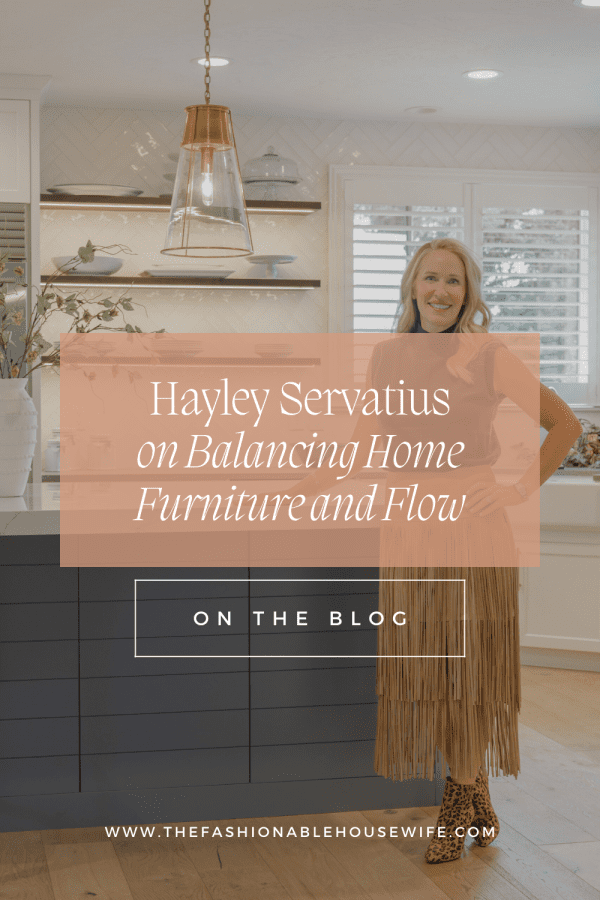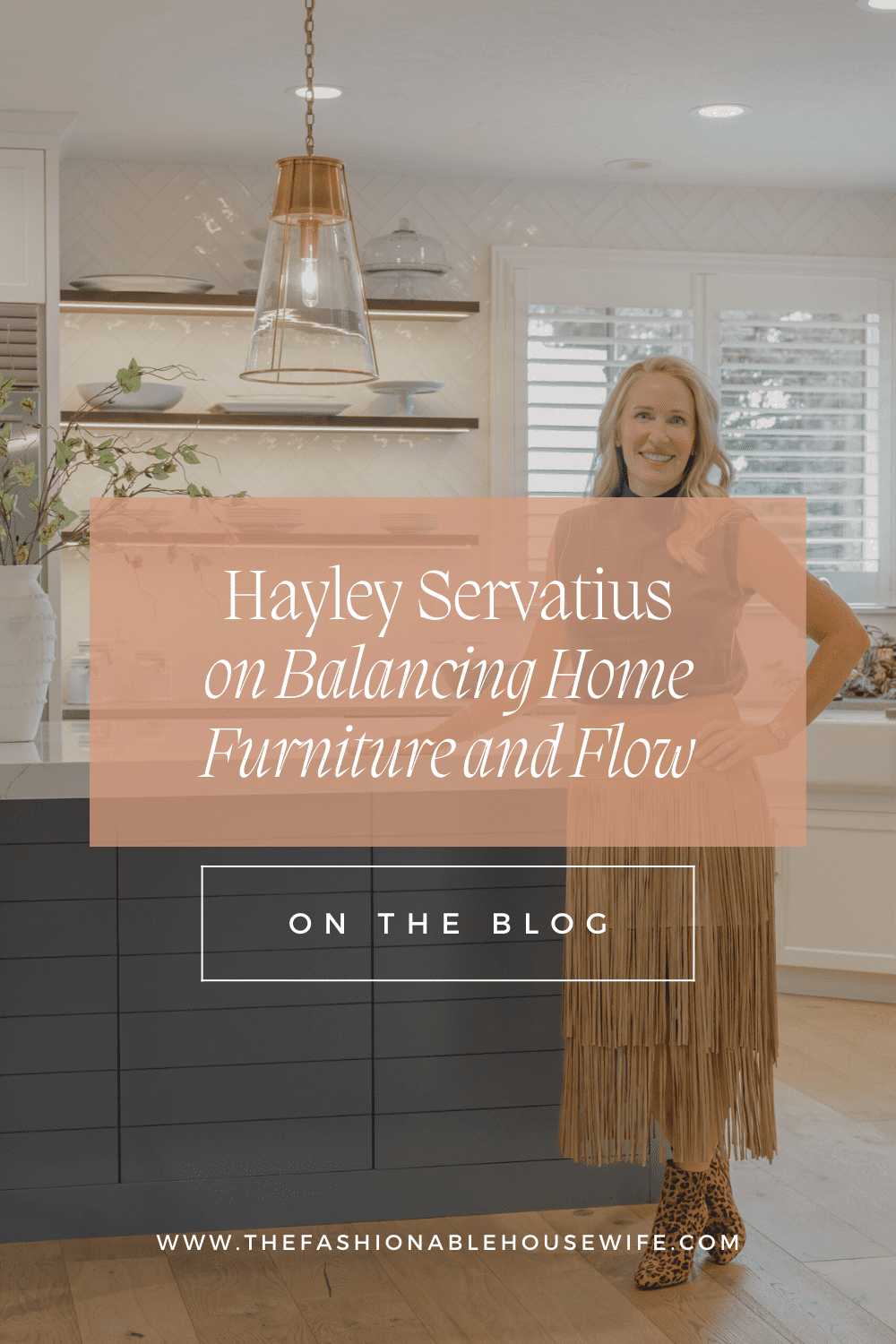Hayley Servatius on Balancing Home Furniture and Flow

Some people say the kitchen is the heart of the home.
Others revere the family room, and some treasure their man cave. But the true heartbeat of every abode starts with the way furniture flows, connects, and brings everything to life.
That pure delight when a room feels like a perfect puzzle, where every piece of furniture completes the picture rather than just fills the gaps.
I’m interior designer Hayley Servatius, and over the years, I’ve helped countless clients create that perfect balance.
Let’s explore how to bring that effortless flow into your home.
The First Step in Every Room: Follow the Flow
Imagine this: You walk into a room. What are the first steps your body naturally wants to take? Where does your eye land first? For me, identifying this subconscious journey is the primary task in every design project.
What I find so powerful about this approach is that it respects the flow of how we naturally move through our spaces — especially in a room shared by a family or used for entertaining.
Once I’ve established those pathways, the next step is all about lighting. Whether natural or artificial, lighting has a way of sculpting a room.
It dictates the mood, highlights key areas, and draws attention to special features, like a cozy reading nook or a dramatic piece of art.
If you think about it, light is like the jewelry of a room: It adds sparkle and polish — but only if you know how to make it work for you.
And, let’s not forget one of the most essential considerations of all: the purpose of the space. Every room needs its unique identity. Is it for family time, for hosting elegant cocktail parties — or maybe it’s your personal sanctuary for some peace and quiet? Determining the room’s intention helps to guide every choice.
If a room is meant for family gatherings, you’ll want furniture that’s cozy, durable, and encourages togetherness. In contrast, a space designed for solitude or more refined gatherings may call for furniture with sleeker lines, a more polished aesthetic, and arrangements that allow for a little breathing room between pieces.
The Importance of Balance and Comfort
Balance plays a huge role in how we experience a space. It’s the subtle dance between function and form, between comfort and aesthetics.
Often, there’s this misconception that a room has to be one or the other — either comfortable or beautiful.
Why can’t it be both? Why can’t a room be a place where you sink into a sofa with a favorite book and still feel like you’re buried within the pages of a design magazine?
Comfort doesn’t have to be sacrificed on the altar of design, but it does need some clever thought.
For instance, when working with larger rooms, it’s tempting to go all out with oversized, plush furniture, thinking it will naturally fill the space and provide comfort.
But too much bulk can weigh a room down and kill the flow we’re after. I prefer mixing it up, keeping a balance of more substantial, cozy items with more delicate pieces, like a glass coffee table or slimline side chairs.
One trick I swear by is to never, ever put the back of a sofa toward the main entrance of a room.
Instead, place your furniture in a way that invites you into the space. Think about how it leads the eye, directs movement, and encourages interaction.
Speaking of inviting interaction, let’s talk about one of my favorite pieces: barrel chairs. These little gems are the unsung heroes of a well-designed room. Barrel chairs with the ability to swivel can transform the entire flow of a space.
They’re perfect for versatility. They can face the sofa for conversation but also turn toward a window or a beautiful view when you want to simply soak in a quiet moment. They don’t anchor a room in one direction; instead, they create flexibility, which is crucial to achieving a sense of dynamic balance in any layout.
Creating Zones for Connection and Calm
Furniture placement is all about creating zones within a room. This might sound fancy, but in reality, it’s about carving out areas for specific activities without the need for walls.
In an open-plan living space, you might want to create a cozy zone for reading, a more formal space for entertaining, and a family-friendly spot for movie nights — all within the same room.
The magic here is in the subtle shifts between furniture styles, materials, and even colors. Perhaps the reading nook features a plush armchair, a floor lamp, and a small side table, while the entertaining space boasts a sleek leather sofa and statement artwork. Each zone has its individual character, but they all flow together in a way that feels cohesive.
Again, lighting plays a starring role. The cozy reading nook might benefit from softer, ambient lighting — think a warm glow from a table lamp — while the entertaining area could shine under a bold, modern chandelier.
These different lighting elements help further distinguish each zone while keeping the overall mood unified.
Minimalism or Maximalism? Know Your Style
There’s no one-size-fits-all approach to furniture flow and layout. Some people are drawn to minimalism — crisp, clean lines, fewer pieces, and an airy feel.
Others love the maximalist approach — bold patterns, an abundance of textures, and an eclectic mix of furniture styles. Neither is better; it’s all about what resonates with the person living in the space.
For the minimalist at heart, furniture placement is often about ensuring that each piece has a purpose and a place.
Beauty emerges in restraint, where a room feels spacious and each item has room to breathe without being overwhelmed. Think Scandinavian design principles in which every object serves a function, yet contributes to the overall flow.
On the flip side, a maximalist approach to furniture layout can be just as thoughtful, even if it appears more “chaotic” to the outside eye. In these spaces, layering is vital.
You can mix modern with vintage, and big statement pieces with smaller, whimsical items. But the trick to pulling off maximalism successfully is making sure that even in its abundance, the space still has a rhythm. Everything should feel like it has a “conversation partner.”
The Last Word on Furniture and Flow
Remember this: There’s no absolute right or wrong way.
Every room is its own adventure, and each space tells its own story. What matters most is that it works for the people who live in it.
Furniture should never feel static, and a well-designed space should always leave room for life to unfold naturally.

